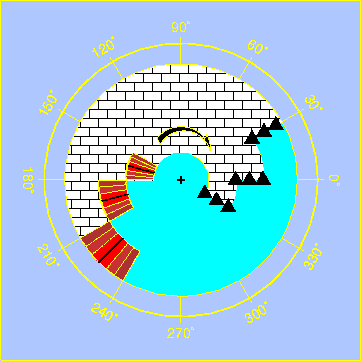Demonstration goals:
- Understand how Euler‘s theorem relates to plate motions
- Know how to apply Euler rotation vectors to find linear velocities at a plate boundary
- Know how to apply Euler rotation vectors to determine boundary type
 This page will deal qualitatively with the concept of plate rotations about and Euler pole; the quantitative treatment is given on our North America-Pacific Plate Motion page.
This page will deal qualitatively with the concept of plate rotations about and Euler pole; the quantitative treatment is given on our North America-Pacific Plate Motion page.
Definition: Euler’s fixed point theorem states that any motion of a rigid body on the surface of a sphere may be represented as a rotation about an appropriately chosen rotation pole, called an Euler pole. Geologists have used this theorem to understand the motions of tectonic plates. What happens at a boundary between two plates depends on the direction of the motion and the orientation of the boundary. In the example shown, subduction, spreading and strike-slip motion are all found.
In the real world, these motions can be observed using the Global Positioning System Satellites and other space geodetic techniques, such as Very Long Baseline radio Interferometry. Geologists have been excited to learn that the motions derived with these techniques over periods of a few years are very similar to those observed over periods of millions of years in the geologic record.
The last frame of the animation shown above illustrates several important facets of plate rotations:
- Subduction zones, or convergent boundaries (purple arrows), occur where two plates come together. The triangles mark the places where volcanoes such as Mt. Fuji, Mt. St. Helens are formed.
- Spreading centers, also known as divergent boundaries (red arrows), occur where two plates move apart. New crust is formed and acquires a remnant magnetization.
- Transform faults, or passive boundaries (yellow arrows) occur where two plates move past each other without either creating or destroying old crust.
- As the oceanic plate rotates counter-clockwise about the Euler pole, new crust is formed in the spreading centers on the Western boundary, while old crust is destroyed in the subduction zones on the Eastern boundary.
- Because we are only dealing with relative motions, we can think of either plate as rotating with respect to the other; hence an equivalent statement is that as the continental plate rotates clockwise about the Euler pole, new crust is formed on the Western boundary, while old crust is destroyed on the Eastern boundary.
Even though the example is simple, the concepts it illustrates are fundamental to the science of plate tectonics. By using paper cut-outs in the 1960’s, scientist such as Vine, Matthews and Cox accurately predicted the motion of plates, and reconstructed their positions in the past. This page gives one simple demonstration of plate rotations; many more can be found in Cox and Hart [1986]
To perform this demonstration in class, you will need:
- A transparency sheet
- Overhead projector
- Scissors
- Pen suitable for marking on transparencies (Vis-a-Vis or equivalent)
- Thumbtack
- A small rubber eraser
- Tape
- A printout of the illustration shown below
Before the demonstration: Photocopy the illustration onto the transparency sheet. Cut the Mantle transparency along the thick line; cut Brickonia and Oceania along their outer edges. (You may want to color Brickonia and Oceania before you cut them out.) Carefully push a thumbtack through the Mantle plate from the back, then place Oceania on top and push the thumbtack through it. Repeat with Brickonia. When you are done, all three crosses should lie one on top of the other. Cap the thumbtack with a rubber eraser. This completes the assembly of the demonstration apparatus.
Double check that the overhead projector in the room is working.
1. Place the Brickonia-Oceania-Mantle apparatus onto the overhead stage. Select one boundary as East.
2. While holding Brickonia fixed with one hand, slowly rotate Oceania counter-clockwise. Note the different types of boundaries (transform, spreading ridge and subduction zone that are formed by the motion of the plates relative to one another.
3. Repeat part 2, only hold Oceania fixed and rotate Brickonia. Note the same boundarie types appear, but that the sense of them is opposite (i.e., what had been a subduction zone is now a spreading ridge, and vice versa).
4. Repeat the previous demonstration, only with the opposite sense of rotation (clockwise).
(This demonstration is illustrated by the rotating gif at the top of this page.)
For Discussion:
How does this demonstration prove that  ? Assuming symmetrical spreading, how does the spreading center move with respect to the two plates?
? Assuming symmetrical spreading, how does the spreading center move with respect to the two plates?
Related pages:

